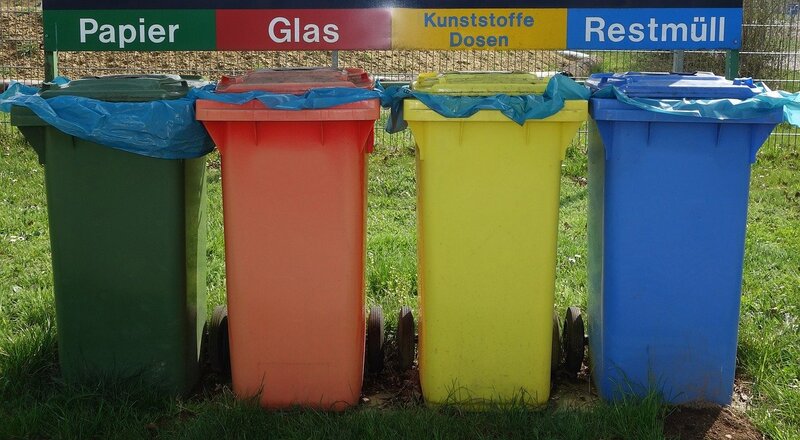While we know that recycling is an effective way to reduce the immense amounts of waste that we have produced, there are many misconceptions around the recycling process. People question whether it’s worth the time and energy to recycle, whether products made from recycled materials work or are of acceptable quality and how much waste is actually recycled. In celebration of Global Recycling Day on March 18, here are 6 myths about recycling that you need to know:
—
Myth 1: Items Made From Different Materials Must be Sorted
Some towns may ask its residents to separate recyclable materials, however many locations, particular in the US, choose to use single-stream recycling, which allows consumers to place all recycled materials in a single bin.
Items recycled using the single-stream process are picked up and transported to a material recovery facility (MCF) for sorting and processing. A benefit of single-stream recycling is that it’s a more affordable and efficient option for taxpayers. Typically, sorted recycling systems are seen in upper class, suburban areas, since the process has a higher cost.
Myth 2: Materials Can Only be Recycled Once
Although this does hold some truth in the case of plastics, other materials like metals, glass and aluminium can be recycled again and again without any degradation to the material’s quality. In fact, aluminium cans have consistently shown the highest value among recycled commodities and remain in high demand.
Plastic has a short lifespan, often only being able to be recycled once or twice into a new plastic product. Items like water bottles are typically broken down into plastic pellets for other manufactured products, like clothing, upholstery and other non-recyclable items. However, it’s still vital to recycle plastic as its impact on the environment is devastating.
Each time paper is recycled, the tiny fibres that comprise it become a little more damaged. However, the quality of paper made from recycled content has improved dramatically over the past few years. The average piece of virgin printer paper can now be recycled five to seven times before the fibres get too degraded to be useful as new paper. After that, they can still be made into lower-grade paper-based materials like egg cartons or packaging inserts.
Myth 3: Separating Regular Trash From Recycling Isn’t Important
Slightly contradicting the first of our myths about recycling, Putting items in the recycling bin that don’t belong there can provoke problems later in the recycling process. In particular, broken glass is important to keep out of the paper recycling bin because it can damage paper processing plants’ machinery.
Even though single-stream systems increase participation and reduce the costs of collection, it can lead to contamination of products. Today, about 25% of everything that consumers place in recycling bins can’t be recycled by the programmes that collect them, including food waste, rubber hoses, wire and low-grade plastics. Such materials waste hauling space and fuel, jam up machinery, contaminate valuable materials, and pose hazards to workers.
In response to this problem, China, which takes in a significant portion of the recycling material collected in the US for processing, will now only accept shipments with a contamination rate of 0.5% or less.
You might also like: Denmark is Building an Artificial Island as a Clean Energy Hub
Myth 4: Products Made From Recycled Content Are of Lower Quality
A few decades ago, products made from recycled materials were often considered to be subpar. Recycled paper was gray and rough and recycled plastic was considered to be weak. However, manufacturers have made considerable strides in quality since demand for recycled products has risen so steadily throughout the years. Numerous studies show that paper with recycled content now meets high performance standards. Further, in the US, the Food and Drug Administration has approved glass, plastic and metal containers with recycled content for use with food products.
Myth 5: Recycling Uses More Energy Than Making Something New
According to the Environmental Protection Agency in the US, recycling aluminium cans saves 95% of the energy needed to make new ones from raw materials, recycling steel and tin cans saves 60-74%, paper about 60% and plastic and glass around a third.
Myth 6: Products Made of More Than One Type of Material Can’t Be Recycled
Finishing off our list of myths about recycling, more than 60% of US households now have access to carton recycling, thanks to wider use of machines that can break down these items into their constituent materials. Product manufacturers have consistently been working on making packaging that is easier to recycle. While it’s always a good idea to check the latest rules for your particular recycling provider, many consumers now no longer have to separate out the plastic windows from envelopes or remove staples from documents. Recycling equipment is now often equipped with heating elements that melt away adhesives or with magnets that strip away bits of metal.
Increasingly, recyclers are able to deal with “less desirable” plastics like grocery bags or items made of mixed or unknown resins. This doesn’t mean you can toss anything you want into the recycling bin, but it does mean a wider range of products can be recycled than ever before.
These recycling myths are problematic because they deter home and business owners from participating in a practical, environmentally friendly task. Implementing a simple recycling programme in your home or business is the first step in reducing your impact on the environment.

















